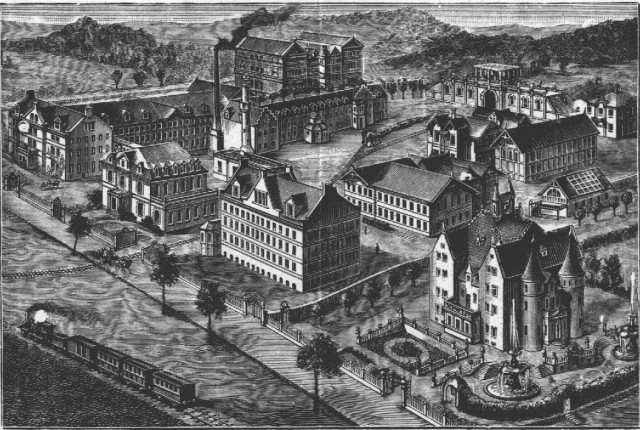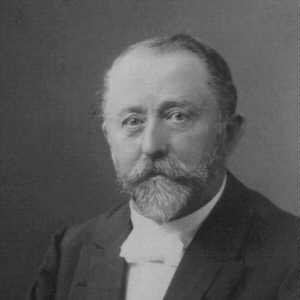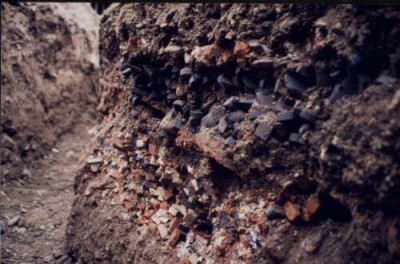
The history of building blocks dates back to the mid -nineteenth century. At that time already toys designed with that specific purpose replaced dolls made of corn's skin and bricks fabricated of wood.
Friedrich Fröbel, the founder of modern kindergarten realized the importance of building blocks as tools of the child's creativity. Dr Jan Georgens, a renowned child educator used Fröbel's theory and experience. He edited a newspaper in the 1870s called "Neuer Kindergarten" (The New Kindergarten), and the educational toys presented there were made and sold under his name. Georgens made use of the artist Gustav Lilienthal's services in his work. Lilienthal made a series of illustrations to Georgens' other books, too. During this job Gustav developed the basis of his building block system. He asked for help from his brother, the engineer Otto Lilienthal at the technical execution. The system's revolutionary novelty consisted of it's material: stone was used instead of wood. Thus, the buildings' stability was totally different.
The brothers' technical and artistic performance was outstanding. This is proved by the fact that their name is written in the histor

y of aviation, several buildings in Australia were erected based upon their plans, etc. Their business skills were less formidable. There is no information about one single sold building block set. As they realized their idea is not profitable, they sold it to an entrepreneur called Friedrich Adolf Richter.
He was the one to take the building blocks to world success. His enterprise in Rudolstadt, Thuringen had in its profile anything that was profitable. His business activity started with the selling of herbal apothecary products. These were good for everything from corns to arthritis. At least he said that, and sales proved that. He bought Germany's oldest glass manufacture (working from 1570). This had to produce bottles for the Richter empire's pharmaceutical products. He also got involved in gramophone making. At the turn of the 20th century, Richter owned the largest recorded sound material in Germany. He also had a chocolate and honey-cake making division. He purchased a publishing house to produce his own goods' packing and advertisement material, including building plans for the blocks. Generally speaking man could say he was a successful entrepreneur, who turned everything he touched into gold. In this company conglomerate the building blocks were one of the success branches.
During it's existence between 1884 and 1963, an estimated three to five billion stones were produced. These were made in different sizes, shapes, and colours. Even the earliest sets proved to be durable. The epoch's stones have a vast secondary market up to the day.
The company faced the blows of two world wars, but resisted only for a short time when Thuringen was left in the Eastern, so-cal

led socialist part after the divison of Germany. The Western commercial links of the Eastern block were drastically reduced. The totally unreliable supplies (e.g. Christmas orders delivered by February) shrank customers' interest.
After eighteen years of struggle, the factory that in

the days of glory was the workplace of 5% of the city, closed its gates. The dictatorship's handicapped mentality is properly depicted by the fact that the blocks on stock when the factory closed, were simply thrown in the courtyard. Whoever passed by, could take as many stones as he liked to. The mound, three feet high, twenty feet long, and an unknown number of feet deep, still exists today, and "bleeds" building blocks. There is no explanation to this barbarism.
After the closing up of the factory, the Anker career was prolonged by a circle of Dutch enthusiasts. The club was founded under the name of Friends of Anker (Club Van Ankervriende - CVA) in 1979. This club made an immense effort in the forty years that passed since in cataloguing the types of stones and sets produced.
A huge impetus to publishing and keeping contact was given by the evolution of information technology and the internet. It is a great help that computer programs may be used as tools for structuring the available data and digitalizing the building plans. The available data can be published easily, only depending on the publisher's computer skills. A not too complicated home page can be made with a small effort, the result not being too aesthetic, but very informative. The Anker enthusiasts from all over the world can contact each other without any problems. Naturally, besides the theoretic research and study, the club's activity always involves great opportunities for very practical things. Building with the sets was and always will be the goal of these stones.
After the German wall fell, the club and a few private persons put up efforts to restart the factory.

The presently produced stones' quality is as good as the old ones', since the recipe and technology is the same. A sample advertisement photo of the newly made sets can be seen on the right. These sets are all of the large caliber new series (Neue Folge - GK). No information regarding the production of small caliber (KK) stones or metal parts are available.
Anyone interested more thoroughly in the building blocks' history can download George F. Hardy's cca. 250 page book from the Downloads section. German and Hungarian translation also available. On this book's cover one may find the design of the church below. This was intended to be a design for a (never produced) supplement set for GK NF 34. The church is Gothic style, and it is know in Achor circles as the Octagonal apse church.
